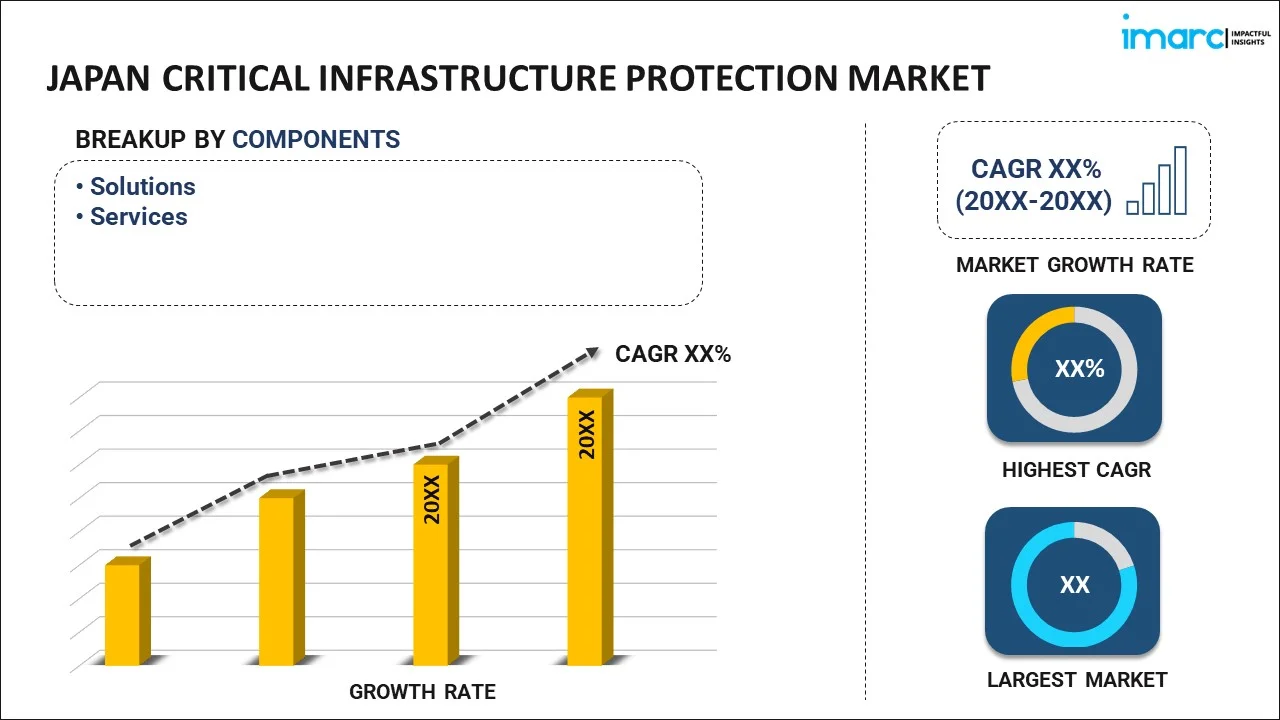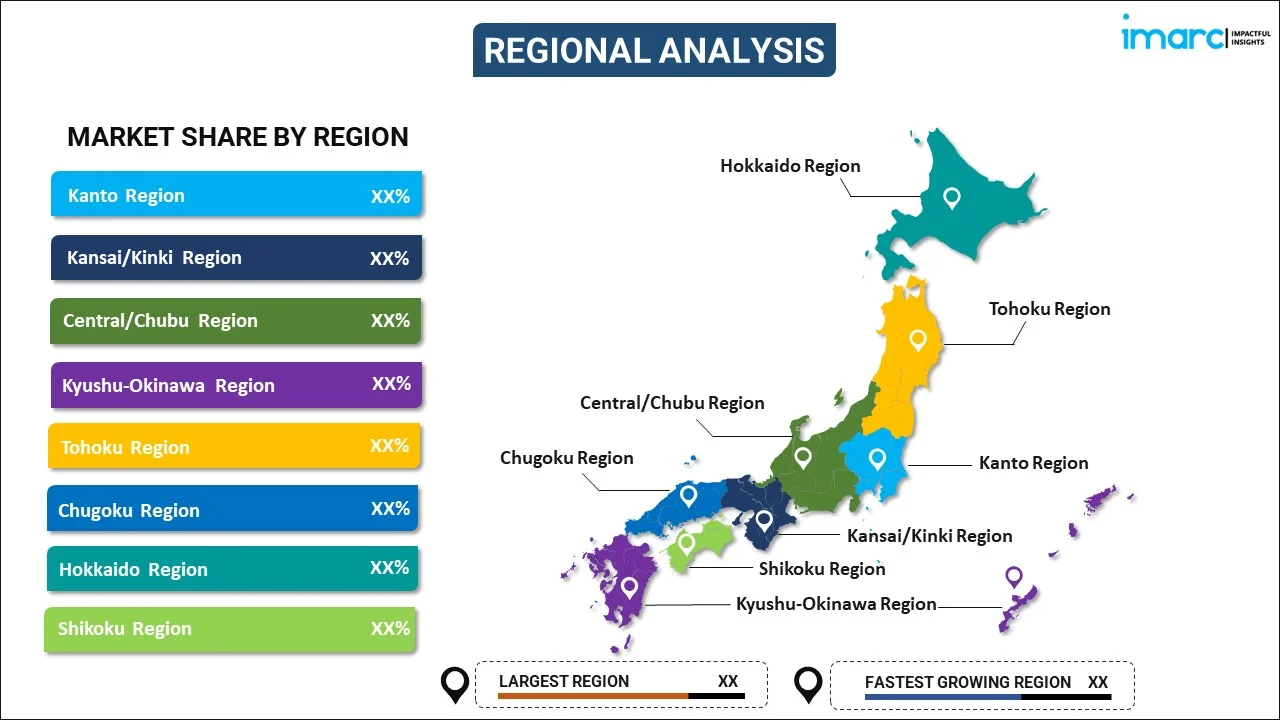
Japan Critical Infrastructure Protection Market Report by Component (Solutions, Services), End User (Financial Institutions, Government, Defense, Transport and Logistics, Energy and Power, Commercial Sector, and Others), and Region 2025-2033
Market Overview:
Japan critical infrastructure protection market size reached USD 8.8 Billion in 2024. Looking forward, IMARC Group expects the market to reach USD 13.3 Billion by 2033, exhibiting a growth rate (CAGR) of 4.3% during 2025-2033. The increasing geopolitical tensions, the continuous evolution and sophistication of cyber threats, the growth of interconnected devices and systems within critical infrastructure, the rising incorporation of AI and ML technologies into CIP solutions, and the escalating emphasis on resilience and recovery capabilities within CIP strategies are some of the factors propelling the market.
|
Report Attribute
|
Key Statistics
|
|---|---|
|
Base Year
|
2024
|
|
Forecast Years
|
2025-2033
|
|
Historical Years
|
2019-2024
|
|
Market Size in 2024
|
USD 8.8 Billion |
|
Market Forecast in 2033
|
USD 13.3 Billion |
| Market Growth Rate 2025-2033 | 4.3% |
Critical Infrastructure Protection (CIP) refers to safeguarding essential systems and assets vital to the functioning of a society, economy, and national security. These critical infrastructures encompass a broad spectrum, including energy grids, transportation networks, telecommunications, water supplies, and healthcare facilities. The primary goal of CIP is to ensure the resilience and continuity of these critical systems in the face of physical and cyber threats, acts of terrorism, natural disasters, or other emergencies. Cybersecurity has become an integral component of CIP in the modern digital age, focusing on protecting information technology systems that control and manage critical infrastructure. Government agencies, private organizations, and regulatory bodies collaborate to develop and implement strategies, policies, and technologies to detect, prevent, respond to, and recover from threats to critical infrastructures. CIP involves risk assessments, vulnerability analyses, and the deployment of advanced technologies, such as intrusion detection systems and encryption, to fortify the defenses of critical systems. This interdisciplinary approach recognizes the interconnectedness of critical infrastructures and aims to create a resilient and adaptive environment capable of withstanding various challenges. As critical infrastructures evolve with technological advancements, the importance of robust and proactive Critical Infrastructure Protection measures becomes increasingly evident, ensuring the stability and functionality of the systems that underpin the essential aspects of modern societies.
Japan Critical Infrastructure Protection Market Trends:
The market in Japan is majorly driven by the increasing recognition of the importance of critical infrastructures in a nation's well-being. In line with this, the escalating frequency and sophistication of cyber threats is significantly contributing to the market growth. Furthermore, as critical infrastructures become increasingly connected through digital systems, the vulnerability to cyber attacks grows, necessitating robust protection measures to safeguard against potential disruptions and ensure the integrity of vital operations. Besides, the rise of smart cities and the integration of Internet of Things (IoT) technologies into critical infrastructure demand enhanced protection mechanisms. The interconnectivity of various systems in smart cities increases the attack surface, making CIP solutions crucial for detecting and mitigating cyber threats that could compromise public safety, transportation, and energy grids. Additionally, the growing instances of natural disasters and the impact of climate change underscore the need for resilient and adaptive critical infrastructures. CIP solutions, encompassing physical security measures and disaster recovery strategies, become essential for minimizing the potential damage from natural disasters and ensuring the rapid restoration of critical services. This, in turn, is creating a positive outlook for the market. Moreover, stringent regulatory frameworks and compliance requirements contribute to the market growth of CIP. The government imposes stringent regulations mandating robust security measures to protect critical infrastructure. This regulatory environment encourages investment in CIP solutions to meet compliance standards, further driving market expansion. The growing awareness of the economic repercussions of infrastructure disruptions fuels the demand for CIP solutions. Businesses and governments recognize the substantial financial and operational losses incurred due to disruptions in critical services, motivating them to invest in comprehensive protection measures.
Japan Critical Infrastructure Protection Market Segmentation:
IMARC Group provides an analysis of the key trends in each segment of the market, along with forecasts at the country level for 2025-2033. Our report has categorized the market based on component and end user.
Component Insights:

- Solutions
- Physical Security Solutions
- Physical Identity and Access Control Systems
- Perimeter Intrusion Detection Systems
- Video Surveillance Systems
- Screening and Scanning
- Others
- Cyber Security Solutions
- Encryption
- Network Access Control and Firewall
- Threat Intelligence
- Others
- Physical Security Solutions
- Services
- Designing and Integration Services
- Consultation Services
- Risk Management Services
- Maintenance and Support Services
The report has provided a detailed breakup and analysis of the market based on the component. This includes solutions [physical security solutions (physical identity and access control systems, perimeter intrusion detection systems, video surveillance systems, screening and scanning, and others) and cyber security solutions (encryption, network access control and firewall, threat intelligence, and others)] and services (designing and integration services, consultation services, risk management services, and maintenance and support services).
End User Insights:
- Financial Institutions
- Government
- Defense
- Transport and Logistics
- Energy and Power
- Commercial Sector
- Others
A detailed breakup and analysis of the market based on the end user have also been provided in the report. This includes financial institutions, government, defense, transport and logistics, energy and power, commercial sector, and others.
Regional Insights:

- Kanto Region
- Kansai/Kinki Region
- Central/ Chubu Region
- Kyushu-Okinawa Region
- Tohoku Region
- Chugoku Region
- Hokkaido Region
- Shikoku Region
The report has also provided a comprehensive analysis of all the major regional markets, which include Kanto Region, Kansai/Kinki Region, Central/ Chubu Region, Kyushu-Okinawa Region, Tohoku Region, Chugoku Region, Hokkaido Region, and Shikoku Region.
Competitive Landscape:
The market research report has also provided a comprehensive analysis of the competitive landscape in the market. Competitive analysis such as market structure, key player positioning, top winning strategies, competitive dashboard, and company evaluation quadrant has been covered in the report. Also, detailed profiles of all major companies have been provided.
Japan Critical Infrastructure Protection Market Report Coverage:
| Report Features | Details |
|---|---|
| Base Year of the Analysis | 2024 |
| Historical Period | 2019-2024 |
| Forecast Period | 2025-2033 |
| Units | Billion USD |
| Scope of the Report | Exploration of Historical and Forecast Trends, Industry Catalysts and Challenges, Segment-Wise Historical and Predictive Market Assessment:
|
| Components Covered |
|
| End Users Covered | Financial Institutions, Government, Defense, Transport and Logistics, Energy and Power, Commercial Sector, Others |
| Regions Covered | Kanto Region, Kansai/Kinki Region, Central/ Chubu Region, Kyushu-Okinawa Region, Tohoku Region, Chugoku Region, Hokkaido Region, Shikoku Region |
| Customization Scope | 10% Free Customization |
| Post-Sale Analyst Support | 10-12 Weeks |
| Delivery Format | PDF and Excel through Email (We can also provide the editable version of the report in PPT/Word format on special request) |
Key Questions Answered in This Report:
- How has the Japan critical infrastructure protection market performed so far and how will it perform in the coming years?
- What has been the impact of COVID-19 on the Japan critical infrastructure protection market?
- What is the breakup of the Japan critical infrastructure protection market on the basis of component?
- What is the breakup of the Japan critical infrastructure protection market on the basis of end user?
- What are the various stages in the value chain of the Japan critical infrastructure protection market?
- What are the key driving factors and challenges in the Japan critical infrastructure protection?
- What is the structure of the Japan critical infrastructure protection market and who are the key players?
- What is the degree of competition in the Japan critical infrastructure protection market?
Key Benefits for Stakeholders:
- IMARC’s industry report offers a comprehensive quantitative analysis of various market segments, historical and current market trends, market forecasts, and dynamics of the Japan critical infrastructure protection market from 2019-2033.
- The research report provides the latest information on the market drivers, challenges, and opportunities in the Japan critical infrastructure protection market.
- Porter's five forces analysis assist stakeholders in assessing the impact of new entrants, competitive rivalry, supplier power, buyer power, and the threat of substitution. It helps stakeholders to analyze the level of competition within the Japan critical infrastructure protection industry and its attractiveness.
- Competitive landscape allows stakeholders to understand their competitive environment and provides an insight into the current positions of key players in the market.
Need more help?
- Speak to our experienced analysts for insights on the current market scenarios.
- Include additional segments and countries to customize the report as per your requirement.
- Gain an unparalleled competitive advantage in your domain by understanding how to utilize the report and positively impacting your operations and revenue.
- For further assistance, please connect with our analysts.
 Inquire Before Buying
Inquire Before Buying
 Speak to an Analyst
Speak to an Analyst
 Request Brochure
Request Brochure
 Request Customization
Request Customization




.webp)




.webp)












